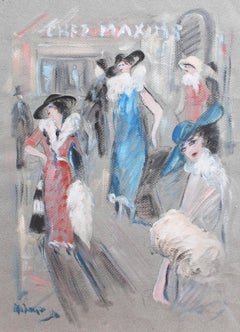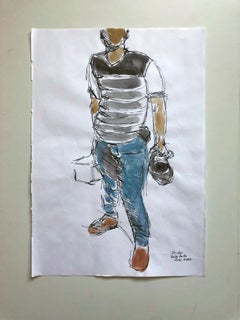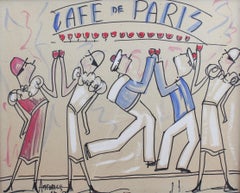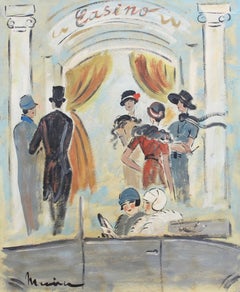André Meurice Art
André Meurice was active in the 20th century. For someone who has had dozens of paintings sold at the international auction houses, surprisingly little is known of his life. Most of his drawings and gouache works depict elegant and glamorous scenes in France from a bygone era.
to
1
1
Overall Width
to
Overall Height
to
1
1
1
1
1
1
1
1
1
1
1
1
8,780
2,809
1,652
1,313
1
1
Artist: André Meurice
Chez Maxim's
By André Meurice
Located in London, GB
'Chez Maxim's', pastel and gouache on fine art paper, by André Meurice (circa 1950s - 60s). The artist depicts the glamorous clientele at the entryway to...
Category
Mid-20th Century Art Nouveau André Meurice Art
Materials
Pastel, Gouache
$657 Sale Price
20% Off
Related Items
Louis Gallait (1810-1887) Portrait of a Gentleman, watercolor and gouache
By Louis Gallait
Located in Paris, FR
Louis Gallait (1810-1887)
Portrait of a Gentleman,
Watercolor and gouache on paper, square white lines,
24 x 16 cm
Stamp of the Louis Gallait Estate on the mount on the lower righ...
Category
1850s Romantic André Meurice Art
Materials
Watercolor, Gouache
Jaider Portrait. Watercolor, Ink and Pastel on Archival Paper.
By Celso José Castro Daza
Located in Miami Beach, FL
Jaider by Celso Castro-Daza
One of a kind
Watercolor, ink, and paster on an archival paper
Sheet Size: 19.50 H x 13.75 W
2018
Unframed
Drawing on paper is his basic work tool, s...
Category
2010s Contemporary André Meurice Art
Materials
Archival Paper, Archival Ink, Pastel, Watercolor
$400
H 19.5 in W 13.75 in D 0.1 in
Jules-Eugène Lenepveu (1819-1898) Portrait of a man in profile, signed drawing
Located in Paris, FR
Jules-Eugène Lenepveu (1819-1898)
Portrait of a man in profile
signed on the lower right
Pencil and heightenings of white gouache on paper
19.5 x 13 cm
Framed : 29 x 22.7 cm
Jules-Eugène Lenepveu is of course particularly well known for his large-scale paintings, such as the one on the ceiling of the Paris Opera, but his work here is much more delicate and intimate. We recognise the artist's mastery of talent, but the play of textures, with its highlights of white that enliven and illuminate the model's face, is also very subtle.
There's a particularly charming sense of life and impression of light.
Jules-Eugène Lenepveu was born in Angers on 12 December 1819, on the site of the street that now bears his name, into a family of small shopkeepers. The painter showed a deep attachment to his family throughout his life through his correspondence and the many portraits of his relatives.
He entered the drawing school in Angers in 1833, where he was a pupil of Jean-Michel Mercier. There he rubbed shoulders with the sculptor Ferdinand Taluet. He arrived in Paris in 1837 and entered the Beaux-Arts, where he was officially admitted to François-Édouard Picot's studio in 1838. He exhibited his work "L'Idylle" at the Salon of 1843 and, that same year, left for his first visit to Italy. He was awarded the Second Prix de Rome in 1843 for "Cincinnatus recevant les députés du Sénat" (Cincinnatus receiving the deputies of the Senate), then the First Prize in 1847 for "La Mort de Vitellius" (The Death of Vitellius).
A resident at the Villa Médicis from 1848, he was surrounded by painters Alexandre Cabanel, Léon Benouville, Gustave Boulanger, Félix Barrias...
Category
1860s Romantic André Meurice Art
Materials
Gouache, Pencil
Cuban Artist - Caricature of Adolphe Menjou Debonair Devil
Located in Miami, FL
Framed Cuban Artist/Caricaturist Conrado Walter Massaguer presents Hollywood star Adolphe Menjou in a satirical dual portrait. In the foreground, the subject is seen in a dapper top hat, tux, fashionable cigarette and boutonnière, and is shown as being the epitome of being stylishly debonair. To make a larger point about this subject, Massaguer paints a cast shadow of Menjou as a burning red devil who studies his alter ego from above. Keeping with the artist's sarcasm, we see the good and bad in one image. Works by Massaguer are rare and this work is in keeping with his signature style. This work was most likely done on assignment for Life Magazine, Cosmopolitan, The New Yorker or Vanity Fair. Signed upper right. Inscribe lower right. Titled on verso. Unframed, Slight bend to board; toning to board; scattered faint foxing; pin point abrasions to margins, not affecting image. 19-1/2 x 15-1/8 inches board size.
Conrado Walter Massaguer y Diaz was a Cuban artist, political satirist, and magazine publisher. He is considered a student of the Art Nouveau. He was the first caricaturist in the world to broadcast his art on television.He was first caricaturist to exhibit on Fifth Avenue. He was the first caricaturist in the world to exhibit his caricatures on wood. He, and his brother Oscar, were the first magazine publishers in the world to use photolithographic printing.
Self portrait of Conrado Walter Massaguer, depicted on a carrousel ride, with the devil over his left shoulder and an angel over his right. (1945)
He created the magazine Social with his brother Oscar to showcase Cuban artistic talent. The duo later created the magazine Carteles, which became for a period the most popular magazine in Cuba, which was purchased by Miguel Ángel Quevedo in 1953.
In his life, he met and drew caricatures of Franklin D. Roosevelt, Walt Disney, Albert Einstein, the King of Spain, and many others.[ In sum total, he was the author of more than 28 thousand caricatures and drawings.Ernest Hemingway once had to refrain himself from punching Massaguer in the face after the artist drew an unflattering caricature of him. The dictator Gerardo Machado, however, did not punch Massaguer for his own unflattering caricature - he had the artist deported.
He was one of the most internationally renowned Cuban artists of his day, and his art is still regularly featured in galleries across the Western Hemisphere and Europe.
Early life
Massaguer was born on October 18, 1889, in Cárdenas, Cuba.[In 1892, his family moved to Havana.
When the Cuban War of Independence broke out, Massaguer's family escaped the country. From 1896 to 1908, he lived in Mérida, Mexico. However, during this time, his parents enrolled him in the New York Military Academy, where he stayed during school years.
In 1905, after graduating the military academy, he briefly attended the San Fernando school in Havana, where he was tutored by Ricardo de la Torriente and Leopoldo Romañach.
In 1906, less than a year later, he returned to the family home in Mexico.
Career as artist
Early career
While living in Yucatán, Mexico, Massaguer published his first caricatures in local newspapers and magazines. These included La Campana, La Arcadia, and the Diario Yucateco.
In 1908, he moved back to Havana. After returning to the island in 1908, Massaguer began mingling with Havana's aristocratic circles, forming close friendships with some of the city's most powerful and influential men, as well as winning the favor of many women who were quickly charmed by him. Massaguer, largely self-taught, honed his style using the avant-garde techniques he studied from the European and American magazines that were widely available in Cuba at the time.
Cover of the immensely popular Cuban magazine El Figaro, drawn by Massaguer in 1909. This cover depicts two bumbling, incompetent American tourists to the island.
He started drawing for El Fígaro, and was featured prominently on the cover in 1909.
After two years of refining his craft, Havana announced a poster contest aimed at attracting North American tourists to stay in the city during the winter months. Notable figures like Leopoldo Romañach, Armando Menocal, Rodríguez Morey, Jaime Valls, and others also entered the competition. The jury was particularly impressed by the modern execution and creative solution of one piece, signed by Massaguer, who was relatively unknown at the time.
The jury deliberations caused a great controversy.[5] The prize was ultimately awarded to the Galician painter Mariano Miguel, who had recently married the daughter of Nicolás Rivero, the wealthy owner of the conservative newspaper Diario de la Marina. Although Massaguer received only an honorable mention, the fraud scandal caused such an uproar that his name quickly entered the public spotlight, and he became an overnight sensation.
In 1910, he became co-owner of the advertising agency Mercurio, with Laureano Rodríguez Castells. At Mercurio, he led the Susini cigar campaign, and earned substantial wealth.
Massaguer has been described as a restless man, in both mind and body.After earning enough money from his art to begin traveling, he was almost always doing so. He constantly traveled between New York City and Havana, Mexico and France, Europe and the Americas.
In 1911, his reputation among the Havana socialites solidified when he organized his own first public caricature exhibit, and also the first Caricature Salon ever held in the Americas, hosted at Athenaeum of Havana (the Ateneo), and the Círculo de La Habana. Other exhibitors here included Maribona, Riverón, Portell Vilá, Valer, Botet, Barsó, García Cabrera, Carlos Fernández, Rafael Blanco, and Hamilton de Grau.
"Messaguer Visits Broadway." Caricatures of theatrical and literary figures. Elsie Janis, Raymond Hitchcock, S. Jay Kaufman (columnist), Ibanez, author of The Four Horsemen, and Frances White
In 1912, in the New York American Journal, he published his first Broadway drawings.
From 1913 to 1918, he was an editor for Gráfico.
Social
Main article: Social (magazine)
Cover of the magazine Social, July 7, 1923
In 1916, he created the magazine Social with his brother, Oscar H. Massaguer. Social's contributors included Guillén Carpentier, Chacón y Calvo, Enrique José Varona and others.Social has been described as Massaguer's great love in the magazine industry, and was the property that historians say he cared the most about. Social was an innovative magazine, being the first magazine in the world to use a modern printing process called photolithographic printing.
Social set cultural trends, not only in the fashion of Cuba, but in art, politics, and Cuban identity.[11] Social catered to a certain aesthetic in Cuba - that of the sophisticated elite socialite - but Massaguer would also use this magazine to ridicule and jibe against that same class of society when he found their personalities worthy of his contempt.
In Social, readers could find a variety of content, including short stories, avant-garde poetry, art reviews, philosophical essays, and serialized novels, as well as articles on interior design, haute couture, and fashion. Occasionally, the magazine also featured reports on sports such as motor racing, rowing, tennis, and horse riding.The cultural promotion efforts of both Massaguer and Emilio Roig de Leuchsenring are evident in the magazine. Notably, this period overlaps with their involvement in the Minorista Group, which was then at the forefront of the country's intellectual life.[5] Many contributors were devoted members of the group, leading some experts to consider Social as the cultural voice of the Minoristas.
One of the features of Social magazine was its section called "Massa Girls," which was a play on his own name, and pronounced with a glottal 'g' in a similar fashion to the letter in Massaguer.[12] Massaguer drew women as independent and free-thinking, and never drew the woman celebrity as a caricature of herself, but as a free agent surrounded by caricatures.[11] However, Massaguer himself has been described as a womanizer in his personal life, and hesitant to fully embrace every facet of women's liberation.
In 1916, he also established la Unión de Artes Gráficas and the advertising agency Kesevén Anuncios.[9]
The art critic Bernardo González Barroa wrote:
“Massaguer has solved the problem of working hard, living comfortably off what his art produces and not missing any artistic, sporting or social event. His broad, childish laugh, of a carefree individual who carries his luck hidden in a pocket, appears everywhere for the moment, disguising the pranks of pupils that lurk, mock and, finally, flash with satisfaction at finding the characteristic point after having analyzed a soul... Massaguer's personality is beginning to solidify now. He has been the best-known and most popular caricaturist for a long time, but his technique had not reached the security, the mastery of values that he presents in his latest works, which is very natural and explainable”[5]
Carteles
Main article: Carteles
Cover of the magazine Carteles, November 29, 1931
In 1919, Massaguer and his brother created the magazine Carteles.[9] Carteles gained the widest circulation of any magazine in Latin America, and the most popular magazine in Cuba for a time, until that title was claimed by Revista Bohemia. Carteles remained in print until July 1960.This magazine showcased Cuban commerce, art, sports, and social life before the revolution.
In 1924, Carteles took a more political turn, with articles criticizing Gerardo Machado's government. it became a prime example of the humor and graphic design employed by artists like Horacio Rodríguez Suria and Andrés García...
Category
1930s Art Nouveau André Meurice Art
Materials
Watercolor, Ink, Illustration Board
$12,500
H 16.38 in W 12.5 in
'Suzanne', Large Mid Century French Portrait Drawing by Gourdon
Located in Cotignac, FR
French, Mid Century, pastel and crayon portrait of an elegant young lady by Gourdon. Signed and dated bottom left. Trade label to the back board. Presented in period deep 'tray' frame.
This seems to be an early work by the artist and hence it carries his name rather than his later more distinctive signature 'Aslan'. Alain Gordon was one of two brothers, his sibling Michel also went on to achieve notable success with his distinctive 'comic' style.
Alain Gourdon...
Category
Mid-20th Century André Meurice Art
Materials
Paper, Crayon, Pastel, Watercolor, Pencil
$821
H 28.5 in W 23.5 in D 2.25 in
Flora Scottish Female Illustrator Glasgow Girls Pre-Raphaelites
Located in Miami, FL
Annie French was part of the Glasgow Girls group of artists and illustrators who worked in a delicate, feminine, and detailed Art Nouveau and Pre-Raphaelite style. This work, "Flora," is masterfully rendered and decorated with sumptuous floral patterns in the most detailed way. It is signed twice in the upper right quadrant. The mat has a hand-painted decorative border. The work presents better in person, and the viewer can marvel at the minute detail.
The Video is overexposed and light and not representative of color. Use still...
Category
Early 1900s Art Nouveau André Meurice Art
Materials
Ink, Watercolor, Pencil
$29,000
H 9.45 in W 7.25 in D 1 in
Bright Lashes / Head Study No. 93
By Kim Frohsin
Located in Burlingame, CA
Bright Lashes / Head Study No. 93, drawing / painting featuring the head portrait of a young woman. in monochromatic grey, brown and white. The work is created with mixed media on ar...
Category
21st Century and Contemporary Contemporary André Meurice Art
Materials
Charcoal, Crayon, Mixed Media, Gouache, Color Pencil
Bride - Scottish Female Glasgow School Art Nouveau, Aubrey Beardsley
Located in Miami, FL
Scottish female illustrator Annie French renders a charming cropped portrait of a bride in an Art Nouveau / Aubrey Beardsley style with curved theme borde...
Category
Early 1900s Art Nouveau André Meurice Art
Materials
Paper, Ink, Watercolor
$20,000
H 8.5 in W 5 in D 1 in
The Envy - Drawing - Early 20th Century
Located in Roma, IT
The Envy is an original drawing in Ink, Watercolor, and pastel by an anonymous artist in the first half of the 20th Century.
Good conditions.
The artwork is depicted through strong...
Category
Early 20th Century Modern André Meurice Art
Materials
Pastel, Ink, Watercolor
Profile Portrait of a Woman Sitting on a Chair
Located in Stockholm, SE
A finely tuned oval drawing by the Finnish artist Ester Helenius depicting a young woman in profile seated on a chair. The room is suggested only by a diffuse background. Signed and ...
Category
1910s Jugendstil André Meurice Art
Materials
Paper, Charcoal, Gouache
$1,179
H 21.26 in W 16.34 in D 0.79 in
Theatrical Costume - Watercolor by Alfredo Edel - 1895
By Alfredo Edel
Located in Roma, IT
Theatrical Costume is an original pencil, pastel and watercolor realized by Alfredo Edel in 1895.
Good condition, the artwork is from Amleto and represents Ofelia, with a note writes from the artist on the lower margin.
Hand signed with pencil by the artist.
Alfredo Leonardo Edel (1856–1912), sometimes credited as Alfredo Edel Colorno, was an Italian costume designer popular during the late 19th and early 20th century. He worked at the La Scala opera...
Category
1890s Old Masters André Meurice Art
Materials
Watercolor, Pastel, Pencil
$1,965
H 12.21 in W 9.06 in D 0.04 in
Bayus
By Nicholas Conrad Miller
Located in Buffalo, NY
An original mixed media work by Contemporary American artist Nicholas Conrad Miller.
Category
21st Century and Contemporary Contemporary André Meurice Art
Materials
Archival Ink, Gouache, Watercolor
Previously Available Items
Café de Paris
By André Meurice
Located in London, GB
'Café de Paris', watercolour on card paper, by André Meurice (1962). There are several Cafés de Paris in the world, probably the best known is in London'...
Category
1960s Modern André Meurice Art
Materials
Watercolor, Cardboard
The Casino
By André Meurice
Located in London, GB
'The Casino', oil on board, by André Meurice (circa 1950s - 60s). This artist is known for his depictions of nostalgically glamorous scenes in France, mo...
Category
Mid-20th Century Modern André Meurice Art
Materials
Oil, Board
La Ponche St. Tropez
By André Meurice
Located in London, GB
'La Ponche St. Tropez', gouache on paper, by André Meurice (1964). The artist, André Meurice, is known for his depictions of entrancing scenes in France,...
Category
1960s Modern André Meurice Art
Materials
Paper, Gouache
The Grand Prix Monaco
By André Meurice
Located in London, GB
'The Grand Prix Monaco', gouache on paper, by André Meurice (1964). The artist, André Meurice, is known for his depictions of entrancing scenes in France...
Category
1960s Modern André Meurice Art
Materials
Paper, Gouache
Les Corniches of the French Riviera
By André Meurice
Located in London, GB
'Les Corniches of the French Riviera', gouache on paper, by André Meurice (1964). The artist, André Meurice, is known for his depictions of entrancing sc...
Category
1960s Modern André Meurice Art
Materials
Paper, Gouache
André Meurice art for sale on 1stDibs.
Find a wide variety of authentic André Meurice art available for sale on 1stDibs. You can also browse by medium to find art by André Meurice in crayon, gouache, paint and more. Not every interior allows for large André Meurice art, so small editions measuring 16 inches across are available. Customers who are interested in this artist might also find the work of Felician Myrbach, Lucien-Victor Guirand de Scévola, and Marcel Bloch. André Meurice art prices can differ depending upon medium, time period and other attributes. On 1stDibs, the price for these items starts at $534 and tops out at $534, while the average work can sell for $534.




